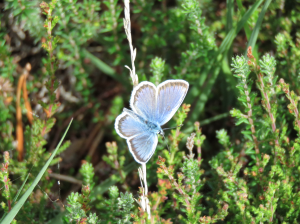It was interesting to read today on Twitter that Portland bird Obs caught their first Willow Warbler of the autumn today, which we’re sure will be the first of many. Willow Warblers main passage period is late July and early August with most having gone through already by the latter part of August. This capture today means young birds are already on the move so it’s worth keeping an eye out in Long-tailed Tit flocks throughout July (and over the next week or two) as ‘Lottie’ flocks are a typical carrier species for migrating passerines such as Willow Warbler and Chiffchaff. This time of year provides a great opportunity to learn a different call type between Willow Warbler and Chiffchaff which allows you to separate the two on call alone, often without even having to see the bird. In 2006 local Poole based publishing company ‘The Sound Approach’ published their first title ‘The Sound Approach to birding’. This award winning title introduces bird song to it’s reader in a manageable and easy to understand format, allowing you to get your head around what can quite often be a challenging topic. Recently the Sound Approach team uploaded their titles onto their website as free ‘Web-Books, and in Chapter 2 of ‘The Sound Approach to birding’ they provide an excellent breakdown and example of the two calls made by both adult and juvenile Willow Warbler and Chiffchaff on autumn migration. Click on the link below to have a read up on this topic. (We highly recommend reading the rest of the book too)!!!!
https://soundapproach.co.uk/put-it-all-together-and-what-have-you-got/
Well, we haven’t had our first migrating Willow Warbler here yet in the harbour, but up on Ballard there were several Common Swift leaving SW out to sea which suggested some of these are already on their way out of here. Also, the BTO Cuckoo tagging project also showed some of their tagged male Cuckoo’s were seen leaving the UK yesterday with one, ‘Valentine’ already almost down in Southern France! At Lytchett Fields there were still 11 Little Ringed Plover, 1 Spotted Redshank, 1 Greenshank, 2 Common Sandpiper and 2 Green Sandpiper with a single Dunlin on the rising tide. On Slepe Heath a Hobby was hunting over the mire and 8 Stonechat were counted. Stonechat seem to have had an excellent season with many juveniles on all the local heathlands. Crossbill were logged at Lytchett Heath (5), Rempstone Forest (7) and Greenlands Farm (4). It’s also worth mentioning that July is the time to keep an eye out for ‘moving’ herons of all species and with the increased breeding numbers of Cattle Egret in the UK, dispersing juveniles from elsewhere in the country could soon be joining our local Little Egrets in various roosts. Take note that juvenile Cattle Egret have black bills like Little Egret, so can be over-looked quite easily.
Silver-studded Blue Butterfly – Hartland Moor

You might also like...
Harbour Update – posted 26/07/24
It was good to get that dank, yucky murk out of the way, which allowed for some new…
Find out moreHarbour Update – posted 25/07/24
You should never right off a good days birding because of the weather, because you just never know….
Find out moreCall 01202 641 003
© 2024 Birds of Poole Harbour Registered Charity No. 1152615
